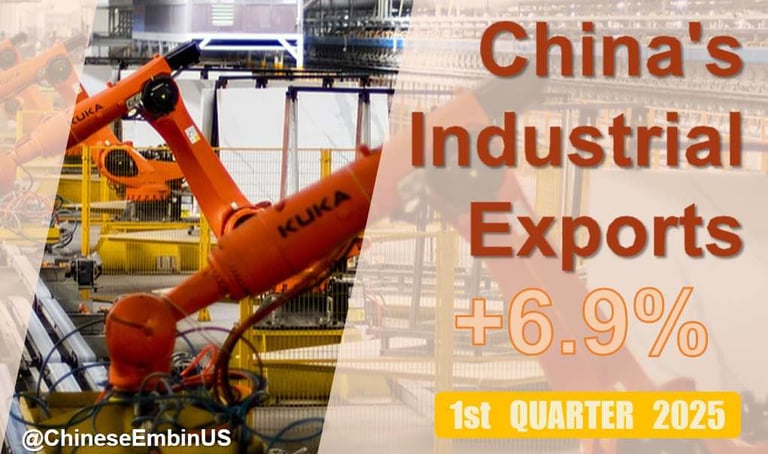China’s Industrial Boom: A 6.9% Export Surge Signals a Shifting Global Economy
4/24/20253 min read


China’s Industrial Boom: A 6.9% Export Surge Signals a Shifting Global Economy
The Numbers That Stole the Spotlight
On April 19, 2025, the Chinese Embassy in the US dropped a post on X that turned heads: China’s industrial exports in Q1 2025 surged by 6.9%, driven largely by machinery and electronics, which saw an impressive 8.7% rise. Domestic demand also got a boost from government stimulus policies, with auto sales climbing 11.2% to 7.47 million units. The real showstopper? New energy vehicle (NEV) sales skyrocketed by 47.1%, totaling over 3 million units. These stats paint a picture of a Chinese economy that’s not just holding steady—it’s accelerating, even as global trade tensions loom. But what does this mean for the world, and why should you care?
A Closer Look at the Surge
Let’s break this down. The 6.9% export growth signals China’s industrial sector is firing on all cylinders, particularly in machinery and electronics. These aren’t just widgets; they’re the backbone of modern tech—think robotics, semiconductors, and consumer gadgets. An 8.7% increase in this category shows China’s tightening its grip on global supply chains, even as the U.S. and other nations push for diversification.
Then there’s the auto sector. With 7.47 million vehicles sold in Q1 alone (up 11.2%), China’s car market is thriving. The standout is the NEV segment—electric and hybrid vehicles—jumping 47.1% to over 3 million units. This aligns with data from Statista, which noted 6.69 million battery-electric vehicles sold in China in 2023, a trend that’s clearly accelerating. Stimulus policies, like trade-in programs and price promotions, are fueling this growth, as reported by the China Association of Automobile Manufacturers (CAAM). China’s betting big on green tech, and it’s paying off.
The Global Ripple Effect
Why does this matter to you? If you’re in the U.S., Europe, or anywhere else, China’s export growth impacts your wallet. More Chinese goods flooding the market can mean lower prices for electronics and cars, but it also intensifies competition for local manufacturers. The U.S., for instance, is bracing for a tariff shock, with UBS downgrading China’s 2025 GDP forecast to 3.4% from 4%, citing Sino-U.S. trade tensions (Reuters, April 16, 2025). Tariffs could disrupt China’s export machine, but for now, it’s full steam ahead.
The NEV boom is another game-changer. China’s dominance in electric vehicles isn’t just about cars—it’s about the future of energy. With over 3 million NEVs sold in Q1, China is leading the charge in sustainable transport, challenging giants like Tesla and traditional automakers. This shift could accelerate global adoption of green tech, but it also raises questions about dependency on Chinese batteries and tech.
The Social Media Reaction
The X post from @ChineseEmbinUS sparked a firestorm of reactions, and not all were celebratory. Some users, like @SuperbadMcLoven, replied with “Free Uyghurs!” alongside an image of Mount Rushmore, hinting at human rights concerns. Others, like @xenortdawon, criticized China’s economic tactics, pointing to currency manipulation and bailouts while sarcastically noting, “Everything is fine!” with a cartoonish image of a Winnie-the-Pooh-esque Xi Jinping. The mix of economic praise and political critique shows how polarizing China’s rise remains.
What’s Next for China—and the World?
China’s industrial export growth is a double-edged sword. On one hand, it’s a testament to resilience, innovation, and strategic policy. Stimulus measures are working, and sectors like NEVs are setting global benchmarks. On the other hand, trade tensions, particularly with the U.S., could throw a wrench in the works. As Reuters noted, China’s economy is expected to grow at a subdued 4.5% in 2025, missing the official 5% target. Global investment banks are slashing forecasts, and the tariff threat looms large.
For consumers, this could mean cheaper goods in the short term but higher costs if trade wars escalate. For businesses, it’s a wake-up call to rethink supply chains and innovation strategies. And for policymakers, it’s a reminder that China’s economic moves ripple far beyond its borders.
Let’s Talk About It
China’s industrial export surge is more than a statistic—it’s a signal of where the global economy is headed. But it’s not without challenges, both for China and the world. So, let’s get your thoughts:
- How do you think China’s export growth will impact your local economy?
- Are you optimistic about the rise of new energy vehicles, or worried about China’s dominance in this space?
- What steps should other countries take to balance competition and cooperation with China?
Drop your thoughts in the comments—I’d love to hear what you think!
hello@boncopia.com
+13286036419
© 2025. All rights reserved.